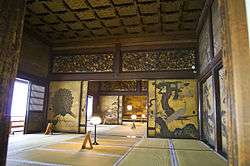Nishi Honganji
| Nishi Hongan-ji 西本願寺 | |
|---|---|
|
Amidadō and Goeidō | |
| Basic information | |
| Location | 60 Horikawa-dōri Hanaya-chō Kudaru Honganji Monzen-machi, Shimogyō-ku, Kyoto, Kyoto Prefecture |
| Affiliation | Jōdo Shinshū |
| Deity | Amida Nyorai (Amitābha) |
| Country | Japan |
| Website | http://www.hongwanji.or.jp/english/ |
| Architectural description | |
| Founder | Honganji Kennyo |
| Completed | 1591 |

Nishi Hongan-ji (西本願寺 Nishi Hongan-ji) "Western Temple of the Original Vow" is one of two temple complexes of Jōdo Shinshū in Kyoto, Japan, the other being Higashi Honganji, or "Eastern Temple of the Original Vow". Jōdo Shinshū is a school of Pure Land Buddhism, and today Nishi Hongan-ji serves as the head temple of the Jōdo Shinshū organization.[1] As with many sites in Kyoto, they have more casual names, and are known affectionately in Kyoto as Onissan (お西さん, Dear Mr. West) and Ohigashisan (お東さん, Dear Mr. East).
History
Nishi Honganji was established in 1602 by the Shogun Tokugawa Ieyasu. Ieyasu split the main Honganji in Kyoto into two temples, Nishi Hongan-ji and Higashi Hongan-ji, in order to diminish the power of the Jōdo Shinshu sect.[1] Nishi Hongan-ji is listed as one of the Historic Monuments of Ancient Kyoto as a UNESCO World Heritage Site.
Temple precinct
Nishi Hongan-ji occupies almost all of a rectangular area bounded by Hanayachō-dōri (Hanayachō Street) to the north, Horikawa-dōri (Horikawa Street) to the east,A Shichijō-dōri (Shichijō Street) to the south, and Shichijō-dōri (Omiya Street) to the west. The main entrance to Nishi Hongan-ji is to the east on Horikawa-dōri. As the name of the temple implies, it is located to the west of Higashi Hongan-ji. Nishi Hongan-ji is older than the latter and has a more integral architecture.[1]
Karamon gate

The Karamon (唐門) is a gate of Nishi Hongan-ji designated a National Treasures of Japan. It is constructed as a four-legged gate with karahafu gables of undulating curves on the front and back.[2] The Karamon gate has a roof in the irimoya style, a style of hip roof sloping down on all four sides and integrated on two opposing sides with a gable.[3] The roof is covered by bark shingles made from hinoki cypress. The gate dates to 1573 and was constructed early in the Momoyama period (1573 – 1614).
See also
- Glossary of Japanese Buddhism
- List of National Treasures of Japan (miscellaneous structures)
- List of National Treasures of Japan (residences)
- List of National Treasures of Japan (paintings)
- List of National Treasures of Japan (writings)
Footnotes
- A.^ The defunct hanamachi courtesan's district of Shimabara is located directly to the west of the north side of Nishi Hongan-ji along Hanayachō-dōri.
References
- 1 2 3 Popular Buddhism In Japan: Shin Buddhist Religion & Culture by Esben Andreasen, pp. 11, 38-39, 105 / University of Hawaii Press 1998, ISBN 0-8248-2028-2
- ↑ Parent, Mary Neighbour, ed. (2001-). "Karahafu (唐破風)". JAANUS: Japanese Architecture and Art Net Users System. Tokyo: Japanese Architecture and Art Net Users System. OCLC 318091406. Retrieved July 4, 2012. Check date values in:
|date=(help) - ↑ Parent, Mary Neighbour, ed. (2001-). "Irimoya-zukuri (入母屋造)". JAANUS: Japanese Architecture and Art Net Users System. Tokyo: Japanese Architecture and Art Net Users System. OCLC 318091406. Retrieved July 4, 2012. Check date values in:
|date=(help)
Bibliography
- Ducor, Jérôme : Terre Pure, Zen et autorité : La Dispute de l'ère Jôô et la Réfutation du Mémorandum sur des contradictions de la foi par Ryônyo du Honganji, avec une traduction annotée du Ha Anjin-sôi-no-oboegaki (Collège de France, Bibliothèque de l'Institut des Hautes Etudes Japonaises); Paris, De Boccard, 2007 (ISBN 978-2-913217-18-8).
| Wikimedia Commons has media related to Category:Nishi Hongwanji. |
Coordinates: 34°59′30.4″N 135°45′6.1″E / 34.991778°N 135.751694°E

